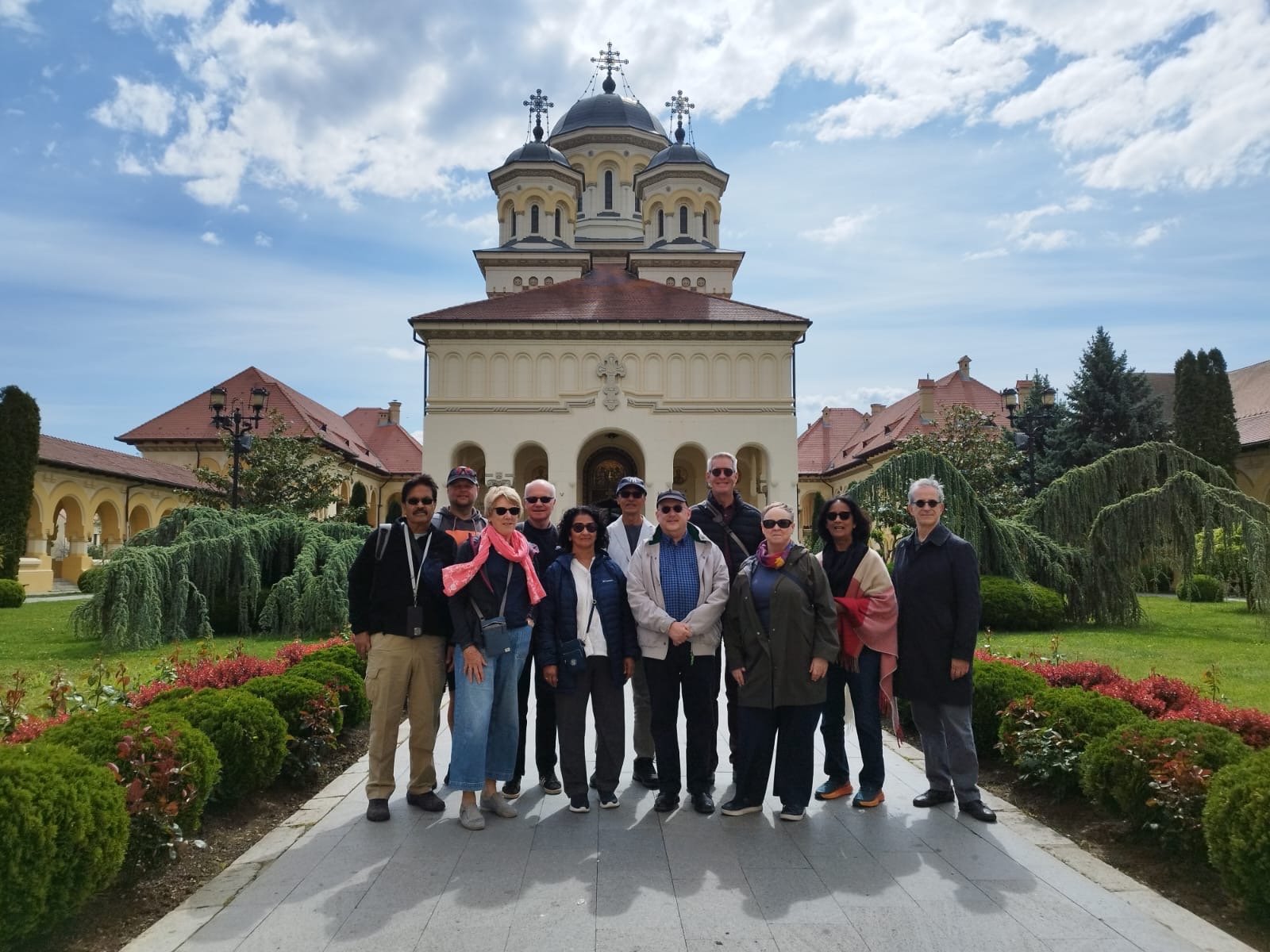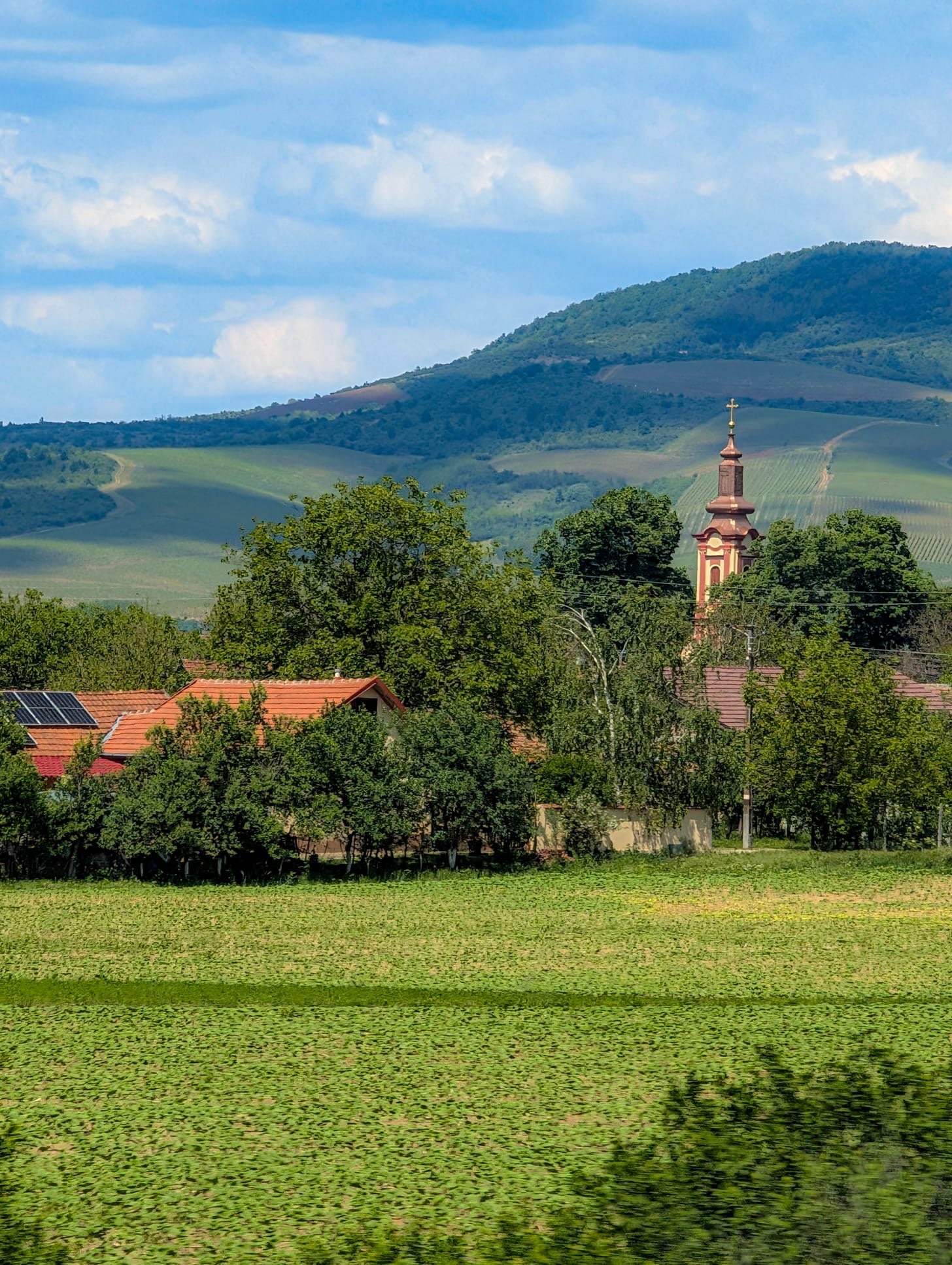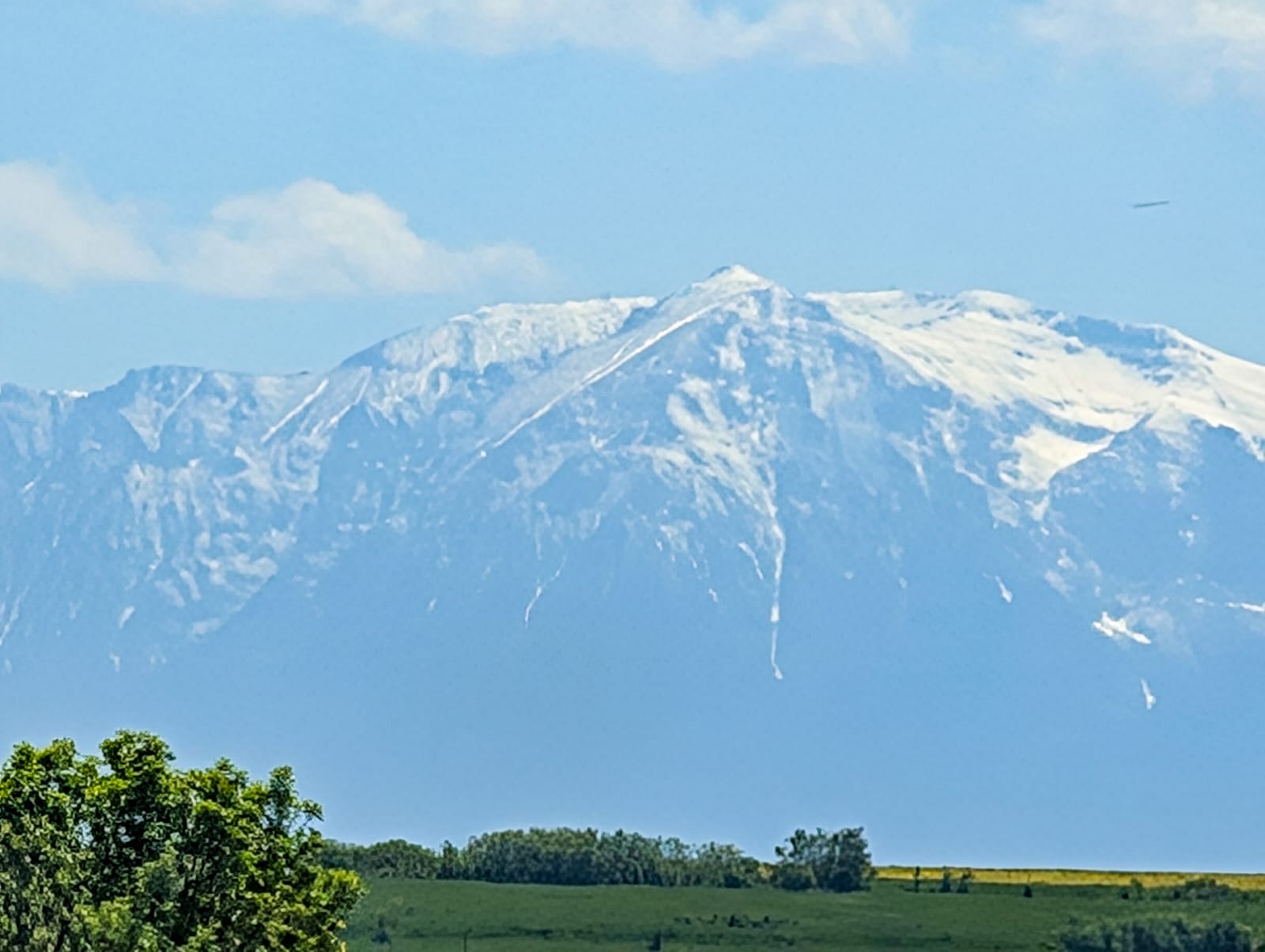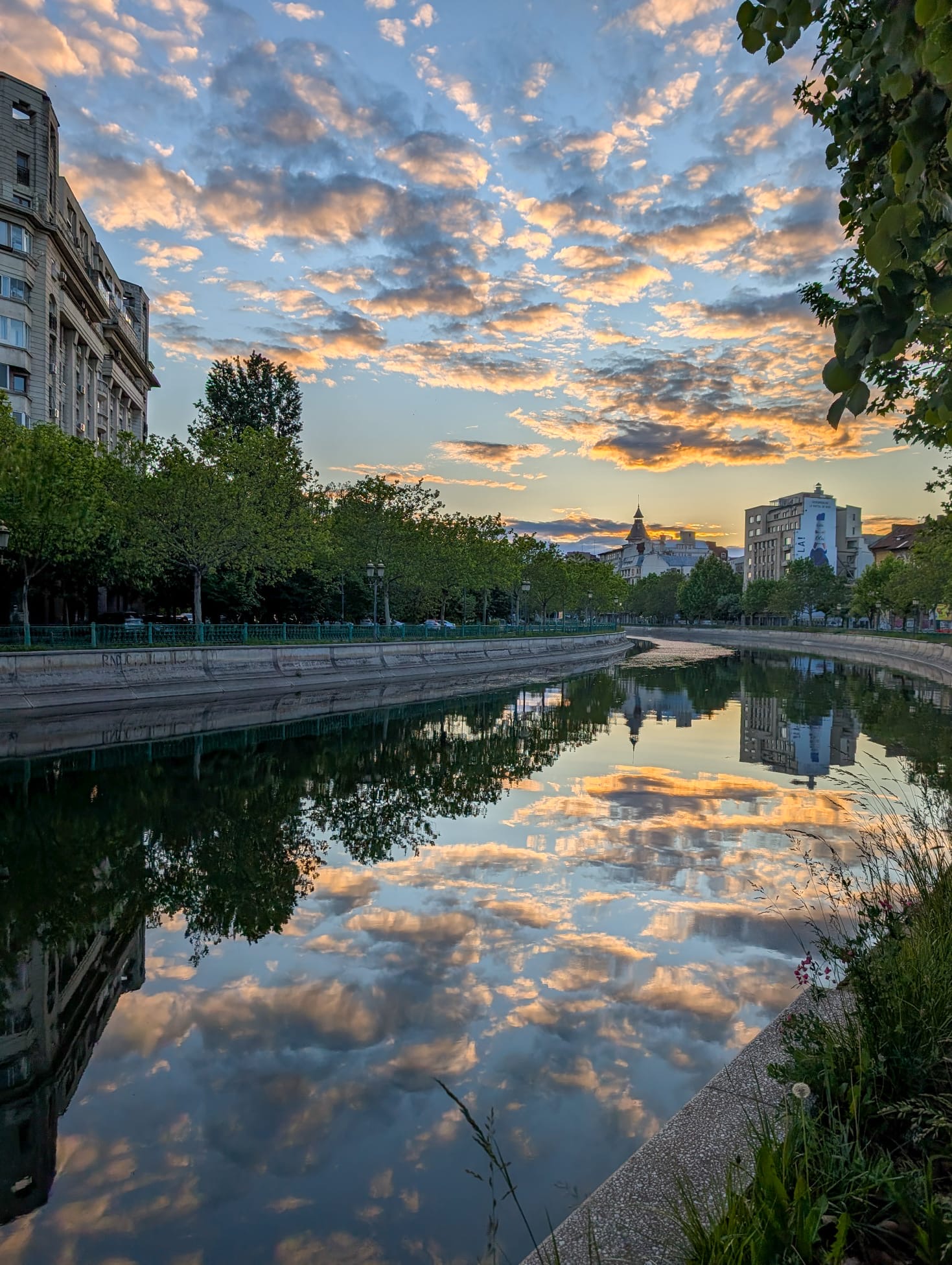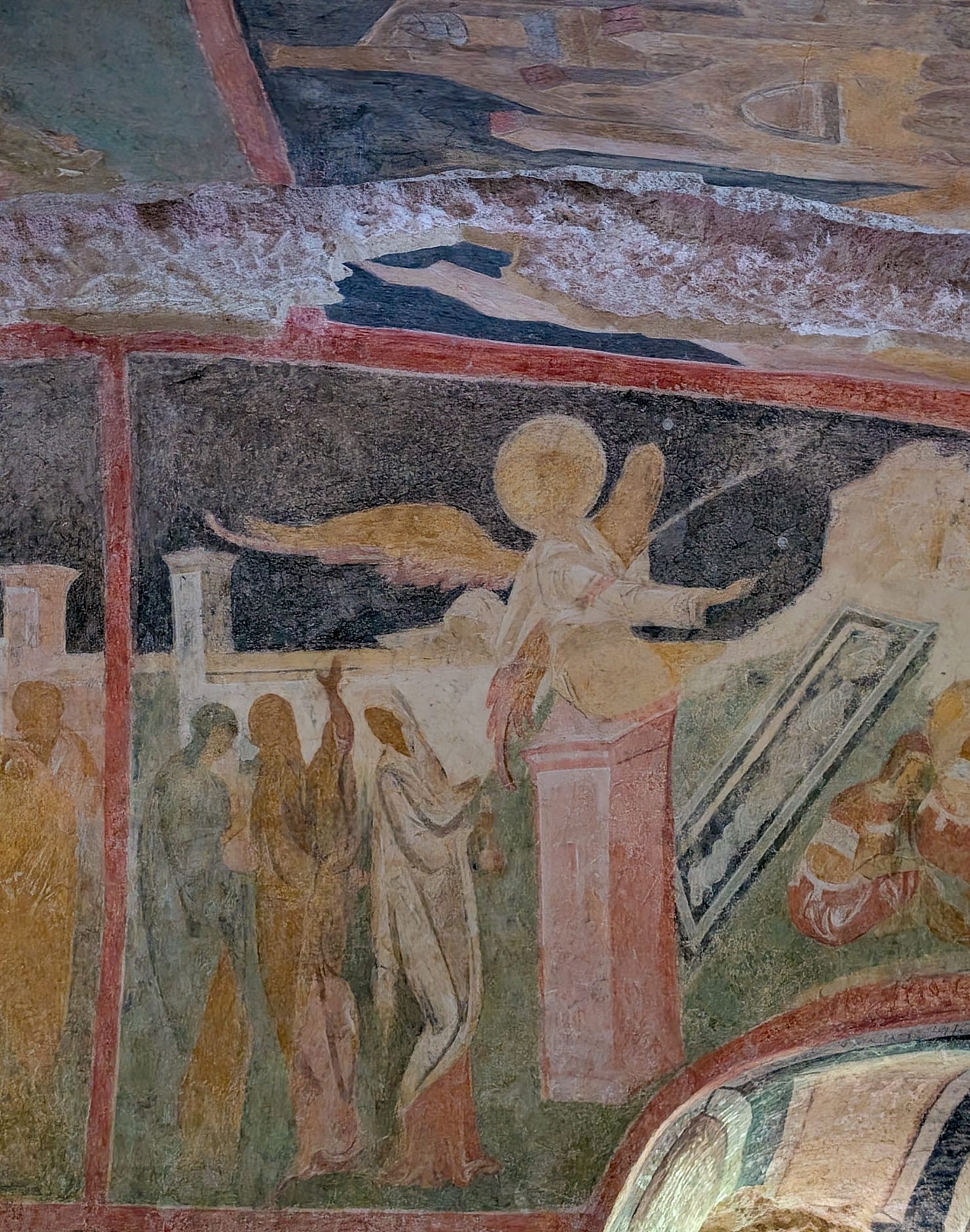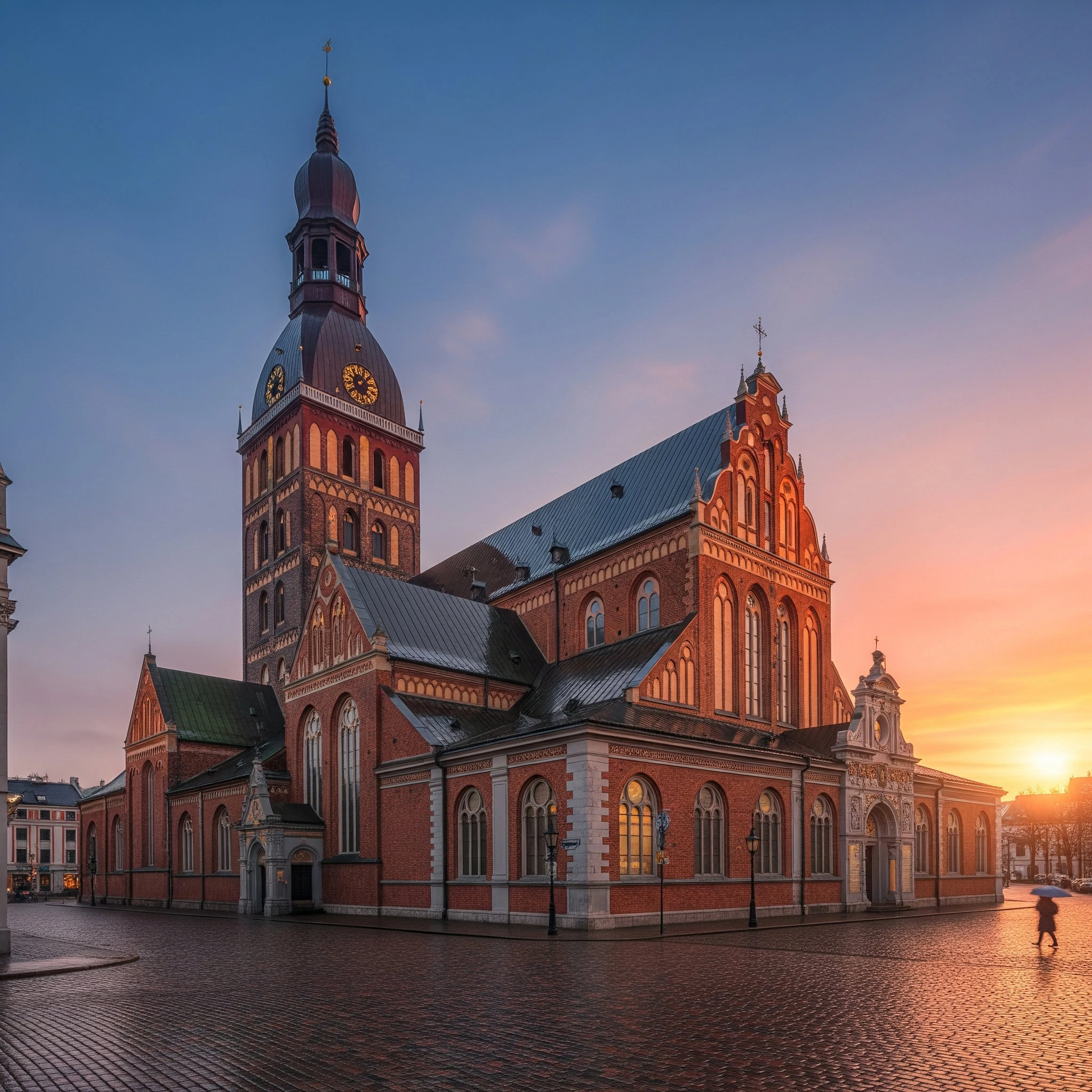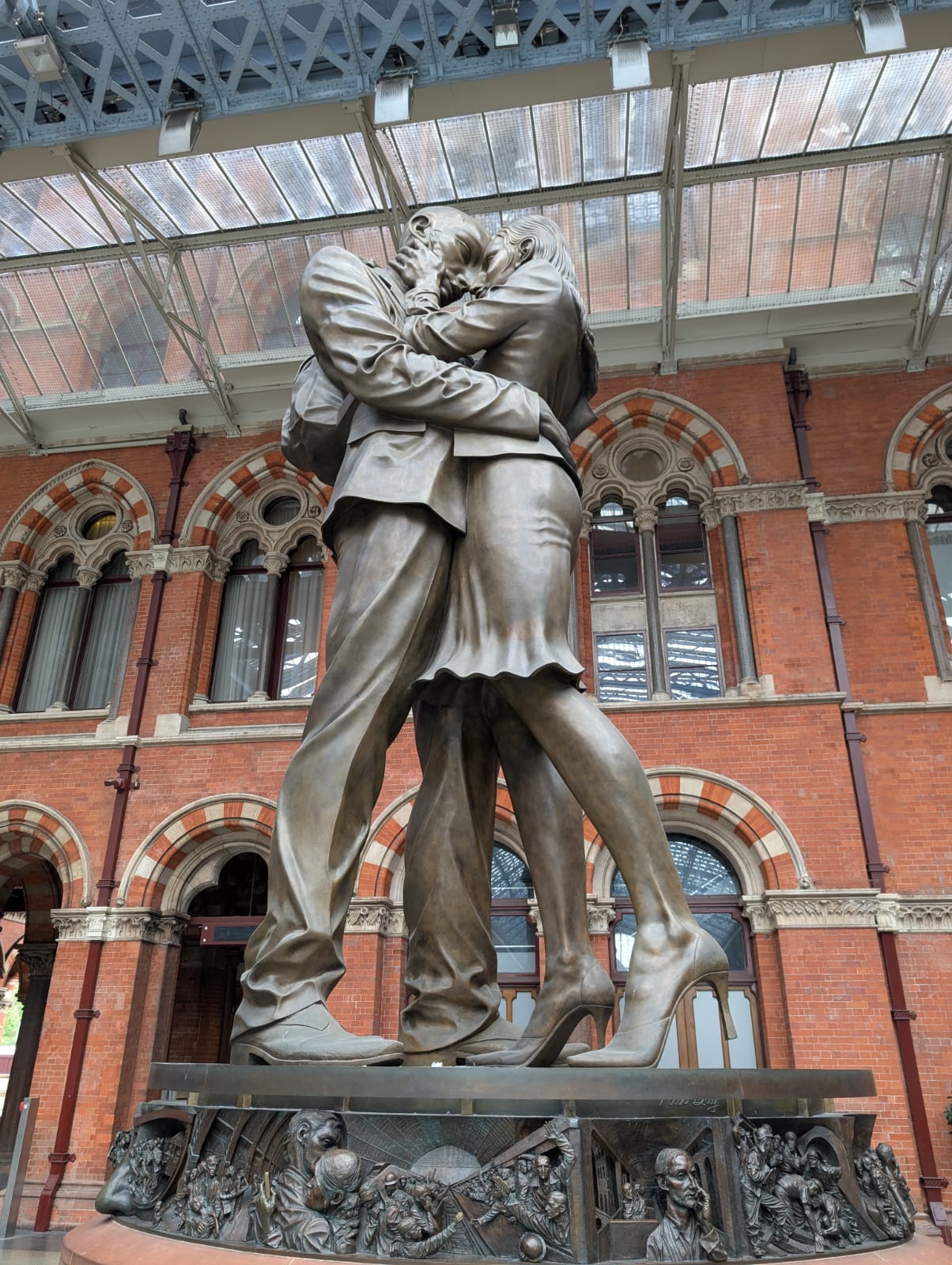
Day 1 – From London to Zurich: A Journey Through Elegance, Cuisine, and Countryside
I met our intrepid overland travellers beneath the elegant canopy of London’s impeccable St Pancras station, under the quietly watchful gaze of Poet Laureate Sir John Betjeman, immortalised in bronze.
After a smooth and efficient Eurostar check-in, we soon found ourselves gliding through the green patchwork of the English countryside. A light breakfast was served at our seats—simple yet satisfying—and even a minor delay (courtesy of a broken-down train ahead, or perhaps the ever-elusive “wrong kind of badger on the line”) did little to dampen the group’s early excitement.
Crossing the Channel, we slipped seamlessly into the French countryside, and before long were rolling into Paris’s Gare du Nord. From there, we made our way to lunch at Bristo S, a charming gem tucked away on a typically Parisian side street—shaded, refined, and alive with quiet conversation.
The food was exquisite. We began with starters of confit trout and a silken Permentier cream accented by thyme emulsion. Mains offered a choice between delicately seared yellowtail and perfectly crisp chicken, both served with Lazio turnip. Dessert was a showstopper: a refreshingly tart raspberry sorbet paired with seasonal fresh fruits.
Sated and content, we strolled to Gare de Lyon and took a moment to appreciate the splendour of the iconic Le Train Bleu. Though a planned lunch here was curtailed by a “social movement” among the kitchen staff, we were warmly welcomed for a drink, and took the opportunity to soak in the historic opulence of this legendary meeting place for travellers since 1900.
Soon it was time to board our next leg aboard the TGV Lyria to Zurich. As the train sliced through the countryside at speeds of up to 300kph, the late afternoon light gilded the fields and villages outside—an ever-changing tapestry of golden hues and pastoral serenity.
Passing Dijon and Mulhouse, we crossed into Switzerland. A brief layover in Basel gave way to the final stretch, and an hour later we arrived in Zurich. Our hotel, just a short stroll from the station, offered a comfortable refuge for a well-earned night’s rest.
Tomorrow, we venture into the Alps.
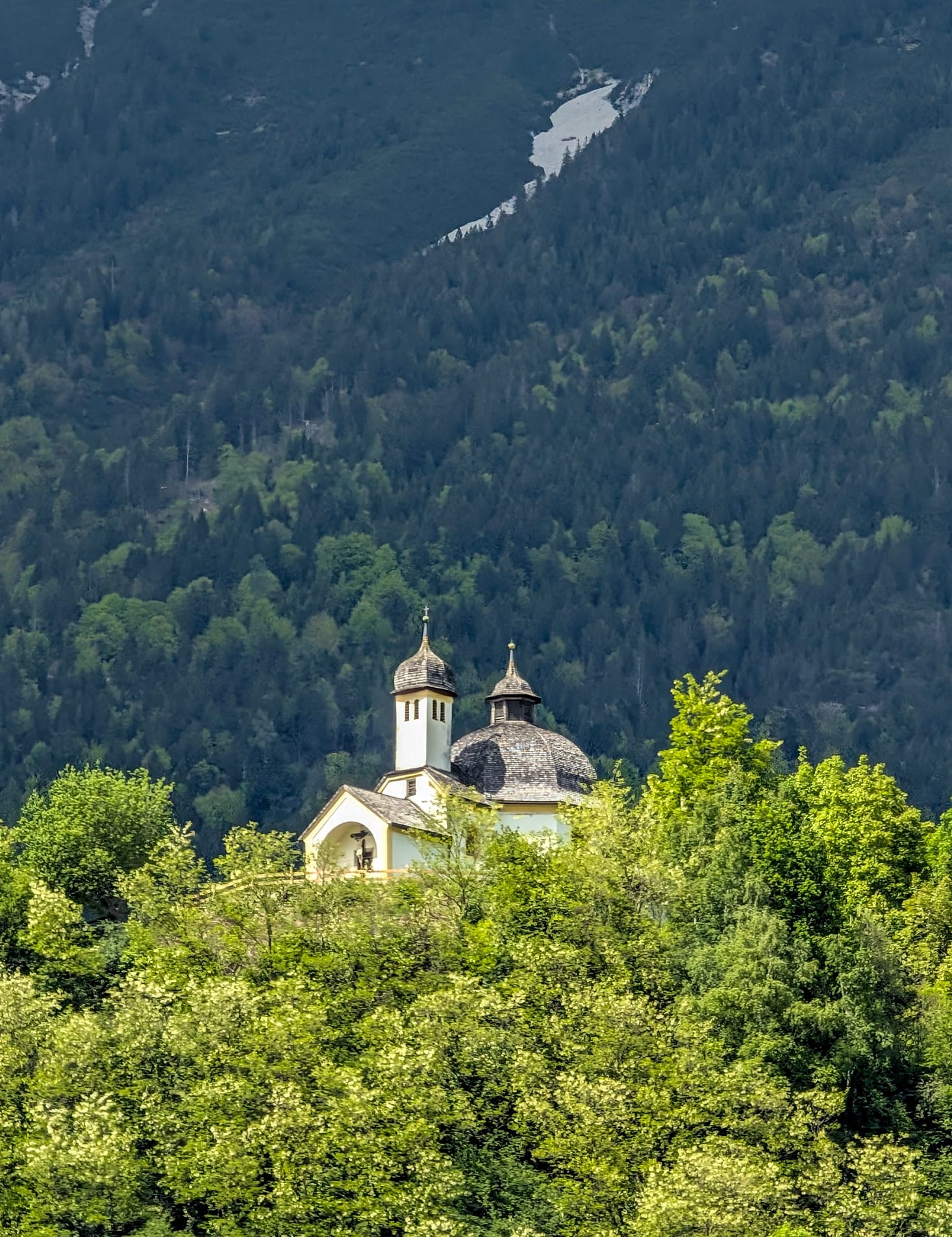 Day 2 – From London to Zurich: A Journey Through Elegance, Cuisine, and Countryside
Day 2 – From London to Zurich: A Journey Through Elegance, Cuisine, and Countryside
I met our intrepid overland travellers beneath the elegant canopy of London’s impeccable St Pancras station, under the quietly watchful gaze of Poet Laureate Sir John Betjeman, immortalised in bronze.
After a smooth and efficient Eurostar check-in, we soon found ourselves gliding through the green patchwork of the English countryside. A light breakfast was served at our seats—simple yet satisfying—and even a minor delay (courtesy of a broken-down train ahead, or perhaps the ever-elusive “wrong kind of badger on the line”) did little to dampen the group’s early excitement.
Crossing the Channel, we slipped seamlessly into the French countryside, and before long were rolling into Paris’s Gare du Nord. From there, we made our way to lunch at Bristo S, a charming gem tucked away on a typically Parisian side street—shaded, refined, and alive with quiet conversation.
The food was exquisite. We began with starters of confit trout and a silken Permentier cream accented by thyme emulsion. Mains offered a choice between delicately seared yellowtail and perfectly crisp chicken, both served with Lazio turnip. Dessert was a showstopper: a refreshingly tart raspberry sorbet paired with seasonal fresh fruits.
Sated and content, we strolled to Gare de Lyon and took a moment to appreciate the splendour of the iconic Le Train Bleu. Though a planned lunch here was curtailed by a “social movement” among the kitchen staff, we were warmly welcomed for a drink, and took the opportunity to soak in the historic opulence of this legendary meeting place for travellers since 1900.
Soon it was time to board our next leg aboard the TGV Lyria to Zurich. As the train sliced through the countryside at speeds of up to 300kph, the late afternoon light gilded the fields and villages outside—an ever-changing tapestry of golden hues and pastoral serenity.
Passing Dijon and Mulhouse, we crossed into Switzerland. A brief layover in Basel gave way to the final stretch, and an hour later we arrived in Zurich. Our hotel, just a short stroll from the station, offered a comfortable refuge for a well-earned night’s rest.
Tomorrow, we venture into the Alps.
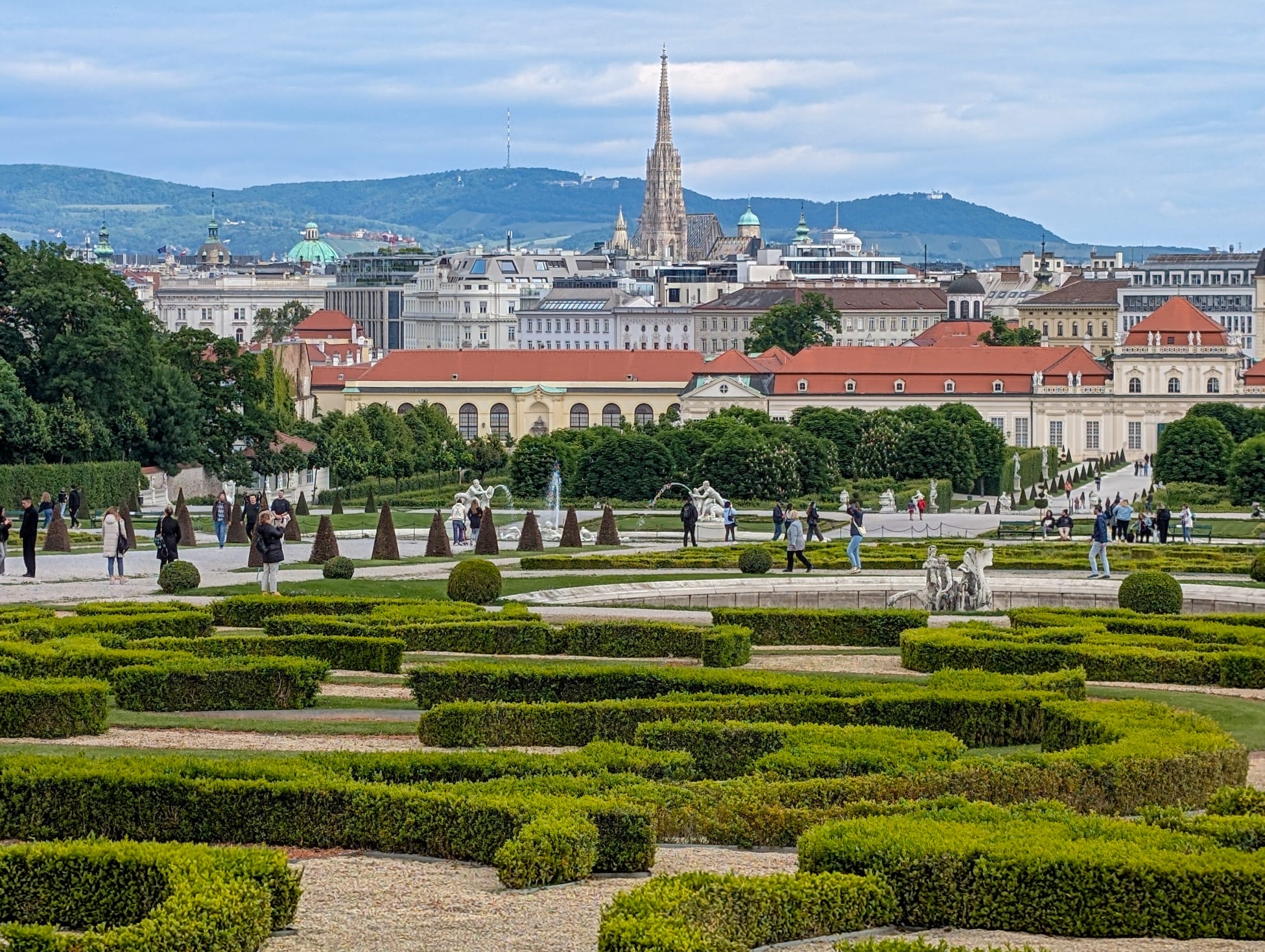 Day 3 – Vienna to Budapest: Imperial Grandeur and Golden Hour Crossings
Day 3 – Vienna to Budapest: Imperial Grandeur and Golden Hour Crossings
Following an impressive breakfast spread at the excellent Novotel, we met our delightfully effusive local guide, Brigitte, for a morning exploration of Vienna. Beneath a cool, clouded sky, our first stop was the splendid Belvedere Palace—an exemplar of Baroque architecture, framed by Italian-style terraced gardens and offering postcard-perfect views over the city below.
From the palace grounds, we boarded a tram—Vienna’s wonderfully efficient and atmospheric way to gain orientation and absorb the city’s remarkable architecture. The sheer volume of ornate façades, stately institutions, and elegant streetscapes would take weeks to properly appreciate; our brief morning was just the lightest brushstroke across Vienna’s immense cultural canvas.
One particularly memorable stop was the Rosengarten, a tranquil public park blooming with rose bushes lovingly planted by locals in memory of those they’ve lost. Though the buds had yet to fully open, one could easily imagine the intoxicating scent and riot of colour that would soon fill this haven in the height of Viennese summer.
Brigitte was a master of the city’s quieter corners, guiding us to lesser-known treasures including the touching statue and fountain dedicated to Empress Elisabeth (“Sisi”), a beloved and complex figure remembered for her unconventional spirit, striking beauty, and deep yearning for a freer life beyond the rigid constraints of court.
We also paused outside the immaculate stables of the Spanish Riding School, where we caught a glimpse of the elegant Lipizzaner horses—ghost-white and graceful, still and statuesque—symbols of aristocratic refinement and living tradition.
A brief visit to Demel, Vienna’s legendary patisserie, offered both olfactory and visual delight. The scent of butter and sugar hung in the air, and among the intricate confections on display stood a spectacular cathedral, crafted entirely from gingerbread—a feat of edible architecture.
Our walking tour concluded at the gothic marvel of St. Stephen’s Cathedral, a towering 136-metre masterpiece at the heart of Vienna. With its multicoloured tiled roof and centuries-old stone, the cathedral remains the spiritual and architectural anchor of this museum-like city.
After a final chance for the group to partake in Vienna’s most cherished ritual—coffee and cake—we took the U1 metro line to collect our luggage and prepare for the next chapter of our journey: onward to Budapest.
As we departed Vienna aboard another smooth and spacious Railjet service, the morning’s greyness gave way to golden afternoon light. We traversed northern Hungary, gliding past quiet villages and broad plains, arriving into Budapest Keleti station just as the sun dipped low, bathing the grand old façade in amber hues.
Just across the road, our Intercity Hotel welcomed us with comfortable rooms and a perfect location. In the soft dusk, I wandered the surrounding streets, stumbling upon a delightful Bangladeshi restaurant—a serendipitous find where a fragrant, richly spiced butter chicken provided the perfect close to a day steeped in imperial splendour and timeless charm.
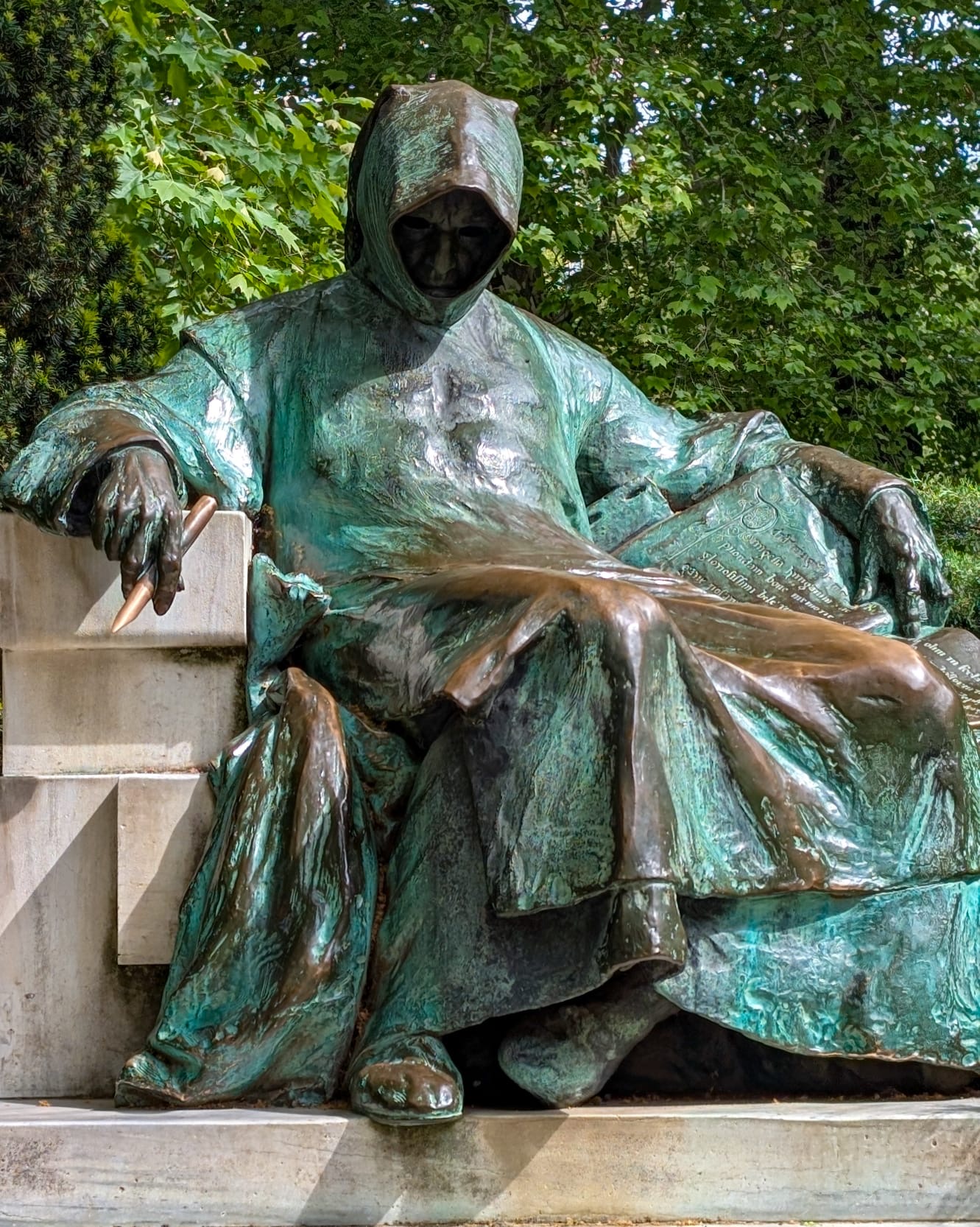
Day 4 – Budapest – Layers of History and Timeless Views
Another cool and cloudy morning greeted us as we met our local guide, the knowledgeable and affable Gabriella, for a deep dive into the fascinating twin cities of Buda and Pest. Boarding our bus, we began the day at Heroes’ Square, an impressive plaza built in the late 19th century. Here, statues of the seven chieftains who led the Magyar tribes into the Carpathian Basin stand sentinel—powerful figures commemorating the birth of the Hungarian nation.
From the square, we enjoyed a leisurely walk through the expansive City Park, a glorious green haven that must become a treasured refuge during Budapest’s sweltering summers. Within the park, we wandered the whimsical grounds of Vajdahunyad Castle, where Gothic turrets and Romanesque arches sit in fairy-tale contrast. We paused at the enigmatic statue of Anonymous, the hooded chronicler of an early Hungarian king—his identity unknown, yet his pen a magnet for aspiring writers who touch it in hope of inspiration. I followed suit, fingers crossed the myth holds true!
A short ride on Budapest’s historic Millennium Underground Railway transported us next—a charming, well-maintained slice of late-19th-century engineering. The quaint carriages and atmospheric stations were a reminder of the city’s layered history beneath our feet.
Disembarking at the Hungarian State Opera House, we admired its intricate façade and slipped inside to marvel at the plush red velvet and glittering chandeliers—a temple to the arts.
Soon, it was time to partake in one of Hungary’s most refined traditions: coffee and cake. In one of Budapest’s elegant pastry cafés, the only difficulty was choosing. The walnut and apple cake ultimately won me over—sweet, spiced, and perfectly balanced. Gabriella reminded us that these establishments frown on screens and earbuds; here, the clinking of china and the soft murmur of conversation are what set the rhythm.
Back aboard the bus, we made our way to Castle Hill, where the sun finally broke through, bathing the Fisherman’s Bastion and Matthias Church in golden light. From this elevated vantage point, we took in spellbinding views over the Danube to Pest, with the Parliament Building’s neo-Gothic spires stealing the show. It’s hard to imagine a more breathtaking urban panorama in Europe.
After thanking Gabriella, we descended on foot, crossing the Chain Bridge to explore the Hungarian Parliament Building up close—its sheer scale and intricate design even more arresting from ground level.
From there, it was back on the subway and a short walk to Bistro Kert near Keleti station for a well-earned late lunch. A crisp glass of Furmint from Tokaj was the perfect accompaniment to toast another unforgettable day in this endlessly intriguing capital.
Day 5 –Journey to Alba Iulia: Into Transylvania
A travel day lay ahead as we boarded the Claudiopolis service from Budapest’s Keleti Station. The train’s layout—with its six-seater compartments opening off a narrow corridor—evoked a charming, almost Harry Potter-esque atmosphere. With the train running fairly quiet, we were able to spread out comfortably for the eight-hour journey to Romania. As there are no catering services on board, we came prepared, having stocked up on provisions before departure.
The early part of the journey took us through the flat rural plains of Hungary—unassuming, yet peaceful. Along the way, the keen-eyed among us spotted birds of prey hovering gracefully above the fields. At one point, a large brown raptor took flight from a tree, and further along, we glimpsed several hares darting through the grass and even the occasional deer grazing near the tracks.
As we crossed into Romania, the landscape began to change dramatically. Verdant, forested hills gradually rose into view, heralding our arrival in Transylvania. For much of the remainder of the journey, we followed the scenic Mureș River Valley, its winding course guiding us deeper into this storied region.
Arriving in Alba Iulia in the early evening, we made the short walk to our hotel, conveniently located just outside the historic citadel walls. After checking in, we took a leisurely stroll into the atmospheric old town. Dinner was enjoyed at a charming restaurant set within the fortified walls themselves—a wonderfully evocative setting to end the day. We’re all looking forward to exploring more of this historic city tomorrow.
Day 6–Exploring Alba Iulia: Citadel Stories and Sunny Streets
A sunny morning greeted us as we stepped out into Alba Iulia, the warmth of the day matching the welcoming spirit of this historic Transylvanian city. After a hearty breakfast, we set off to explore the Alba Carolina Citadel—an expansive, star-shaped fortress layered with history, from Roman roots to the Habsburg era.
Beautifully preserved and impressively vast, the citadel offered a calm and unhurried atmosphere, with wide boulevards, ornate Baroque gates adorned with intricate stone carvings, grand bastions, and sweeping esplanades. It felt more like a living museum than a tourist attraction, with ample space to truly appreciate the grandeur and legacy of the site.
Among the highlights was the Coronation Cathedral, where King Ferdinand and Queen Marie were crowned in 1922—an iconic moment in Romanian history. Just nearby stood the Roman Catholic Cathedral, a stunning blend of Romanesque and Gothic styles and the oldest such structure in Transylvania.
A particularly memorable moment was witnessing the ceremonial Changing of the Guard, complete with soldiers in period costume and stately horses. This evocative ritual brought the past vividly to life, a theatrical flourish that added colour and context to our visit.
Later in the morning, we made our way to Vinoteca Hugo, a wine cellar ingeniously set into the old fortification walls of the citadel. With space for 58,000 bottles, two tasting rooms, and a stylish wine bar with terrace, this atmospheric venue holds a remarkable history. Hidden from public view for decades, the cellar—home to a collection of over 5,000 vintage bottles from 1952–1972—was renovated and opened to visitors in 2018. Within its cool, vaulted catacombs, we enjoyed a tasting of excellent Romanian wines, paired with crusty bread and local cheeses.
Following the tasting, we sat down to a relaxed late lunch at Unio Vini, another gem tucked within the citadel. My carbonara was exceptional—creamy, rich, and perfectly balanced—and was made even better by a glass of crisp Transylvanian Sauvignon Blanc. After our meal, we were led into an adjacent cellar for an engaging interactive session on Romanian wine, where we learned more about the country’s diverse varietals and growing regions.
The rest of the afternoon and evening were left free to wander the cobbled lanes, browse quiet corners, or simply take in the serene ambiance of this lesser-known gem of a city. With its layered history, elegant streets, and lack of crowds, Alba Iulia had thoroughly charmed us.
Day 7–Into the Carpathians: From Alba Iuliato Brașov
We awoke to glorious sunshine and set off for our scenic journey from Alba Iulia to Brașov, nestled in the heart of the Carpathian Mountains. It was the kind of day that invites exploration—clear, warm, and full of promise.
Our route followed the broad valley of the River Olt, weaving through a classic Transylvanian landscape of quaint farming villages and modest towns. Everyday life unfolded gently against a backdrop of rolling pastures, terracotta roofs, and distant hills. Along the way, we passed timeworn fortifications—silent sentinels that whispered stories of Transylvania’s turbulent past, guarding the region’s history in stone.
As the journey progressed, the terrain began to climb steadily. The flatlands gave way to thickly forested slopes and the landscape grew ever more dramatic, the snow-capped peaks of the Carpathians beckoning in the distance. Eventually, we plunged into a long tunnel—the symbolic threshold between lowland calm and mountain grandeur.
Emerging into sunlight once more, we were greeted by the spectacular descent into Brașov, cradled beneath the forested ridgelines of the Carpathians. It was a memorable arrival into one of Romania’s most atmospheric mountain towns—an ideal setting for the next chapter of our Transylvanian adventure.
Our accommodation, the Kronwell Hotel, lay just a stone’s throw from the station—a haven of comfort and convenience. After a short rest and some leisure time, we reconvened for a very special late-afternoon excursion: deep into the forests surrounding Brașov for a chance to observe the Eurasian brown bear in its natural habitat.
A 40-minute 4WD journey brought us into the heart of the forest, where we were met by an expert ranger. From there, we entered a secluded observation hide, fitted with a wide panoramic window. The area is part of a conservation initiative designed to keep bears focused on safe, natural feeding grounds rather than scavenging in urban areas—helping reduce human-wildlife conflict in nearby communities.
We were fortunate: several bears appeared, some remarkably close to the hide, allowing us to observe these majestic creatures in silence and awe. It was a powerful and moving experience—watching the quiet strength and elegance of these animals, entirely in their element.
After an hour of unforgettable wildlife watching, we returned to Brașov as dusk fell—hearts full, minds racing, and still buzzing from the privilege of witnessing nature at its most raw and beautiful.
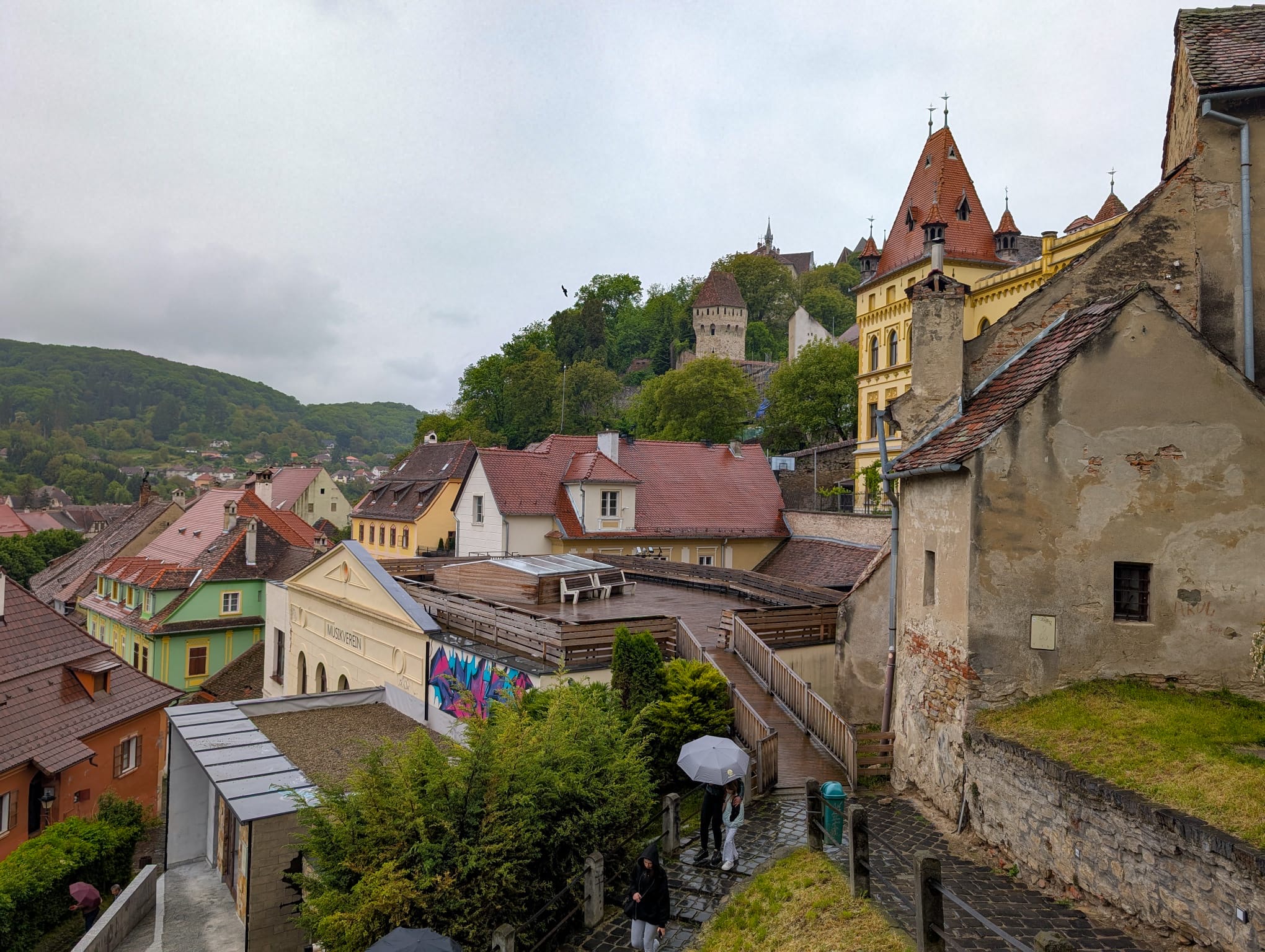 Day 8 – Timeless Transylvania: Sighișoara, Viscri & Rupea Citadel
Day 8 – Timeless Transylvania: Sighișoara, Viscri & Rupea Citadel
The day began under a grey, overcast sky, but spirits remained high—we had a full-day excursion ahead to explore some of Transylvania’s most storied and atmospheric historical sites.
Our first stop was the dramatic Rupea Citadel, perched high atop a rocky hill. One of Romania’s oldest archaeological sites, the fortress afforded breathtaking 360-degree views of the surrounding hills and valleys, and its tiered walls and winding paths made for a striking introduction to the region’s medieval past.
We continued onward to the picturesque Saxon village of Viscri, home to one of the best-preserved fortified churches in Transylvania. This 14th-century structure, a UNESCO World Heritage Site, stood proudly in its rural setting—its whitewashed walls and stout towers testaments to centuries of community and faith. The village itself offered a serene snapshot of pastoral life, with its cobbled lanes, traditional houses, and rolling meadows. We strolled at leisure, soaking in the atmosphere and pausing at the property owned by King Charles III, where visitors are invited to wander through its ecologically sensitive gardens. A highlight here was viewing the Transylvania Florilegium, a richly illustrated botanical masterpiece initiated by the King during his time as Prince of Wales, celebrating the biodiversity and beauty of the region.
Our final stop was the magical medieval town of Sighișoara, another UNESCO-listed gem and one of Europe’s best-preserved citadels still inhabited today. Birthplace of Vlad Țepeș—better known to many as Vlad the Impaler, the inspiration behind the Dracula legend—Sighișoara exuded a fairytale charm. We meandered through its cobbled alleys, flanked by colourful Saxon buildings, climbed toward the ornate Clock Tower, and took in sweeping views across the rooftops. The entire citadel seemed to breathe history, each corner offering up glimpses into a bygone world.
By early evening we returned to Brașov—tired, inspired, and deeply moved by the richness of rural Transylvania, where tradition, folklore, and heritage continue to weave their timeless spell.
Day 9 – From Brașov to Bucharest: Farewell to the Carpathians
Our final morning in Brașov dawned under sullen skies as we prepared to bid farewell to the dramatic landscapes of Transylvania and journey south to Romania’s vibrant capital, Bucharest.
After a hearty breakfast, we boarded the train for a scenic descent from the Carpathians. The route meandered through wooded foothills, gradually opening onto the expansive, fertile plains of southern Romania. As the mountains slipped away behind us, the landscape softened, heralding our approach to the energetic heart of the country.
Upon arrival in Bucharest, we made our way to the hotel for check-in and some well-earned rest. Later, we met our local guide for a tour combining vehicle travel and walking through the city’s contrasting layers. Often called the “Paris of the East,” Bucharest impresses with its wide boulevards and elegant Belle Époque buildings, standing in juxtaposition to stark communist-era blocks and vibrant urban street life.
Key highlights of our exploration included the colossal Palace of the Parliament, reputedly the second-largest administrative building in the world. Despite its architectural grandeur, locals often regard it as a symbol of Ceaușescu’s excesses, much of its vast interior remaining unused. We also visited Revolution Square and the Royal Palace before strolling along Calea Victoriei, once the city’s most fashionable boulevard.
As the tour drew to a close, the previously grey skies softened, bathing the city in a gentle late afternoon light. We relaxed with refreshing drinks at a stylish bar, soaking in the atmosphere. Later, I wandered back to the hotel along the Dâmbovița River, just in time to witness a glorious sunset. Soft, cotton-wool clouds drifted across the sky, casting shimmering reflections on the water as the city’s architecture glowed warmly in the fading light—a poetic end to a day full of transitions and new impressions.
Day 10: Bucharest to Sofia with the Churches of Ivanovo
Given the lack of a convenient rail service, today we travelled from Romania into Bulgaria by road to plug the gap in our overland train adventure, en route to Bulgaria’s underrated capital, Sofia, by road. After crossing the mighty Danube, we continued to the rock-hewn Churches of Ivanovo, a UNESCO World Heritage Site. From the car park, you take a relatively easy short walk, gradually snaking up hillside, eventually coming to the plateaux with windswept views, then hugging the hillside for a short distance to the entrance of a quite remarkable medieval church, perched some 100 feet above the valley and filled with vibrant frescoes, and impossibly carved into a cliff. The far end of the church has a small balcony you can exit out onto for exhilarating although somewhat vertiginous vistas. After the visit we continued our journey to the capital, checking in at the opulent Hyatt Regency Sofia in the centre of town. After freshening up, our local guide took us for a welcome stretch of the legs through the pleasant treelined city streets to our dinner reservation. First impressions of Sofia were overwhelming positive, it felt compact and welcoming with tantalising views of the surrounding mountains that guard over the city.
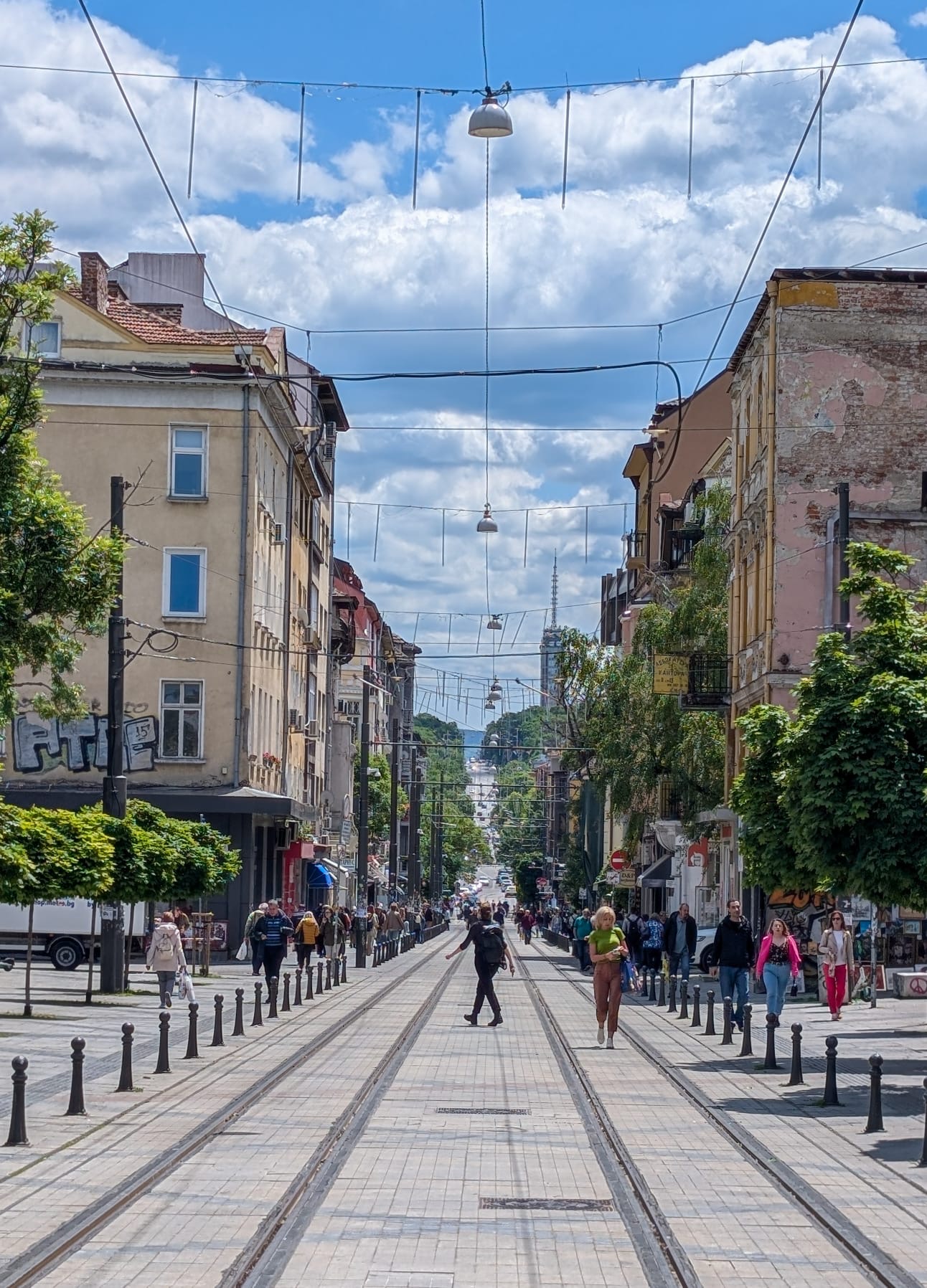
Day 11 – Exploring Sofia: A City Tour of History, Culture, and Charm
Our guided tour of Sofia began with a journey to the serene outskirts of the city, where we visited the UNESCO-listed Boyana Church. Nestled in beautiful gardens resplendent with flowers, this 13th-century church is famed for its stunning frescoes—exceptional examples of Eastern Orthodox art, remarkably preserved in vibrant detail. The tranquil setting added to the sense of reverence and wonder.
Returning to the city center, we explored the ancient Roman city of Serdica, discovered beneath the modern streets. Through glass panels embedded in the pavement, we glimpsed ancient Roman streets, baths, and an amphitheatre—reminders of Sofia’s origins stretching back millennia. This striking contrast of old ruins woven into the fabric of a bustling modern city offered a fascinating glimpse of history alive beneath our feet.
Our next stop was the Largo, a monumental Soviet-era architectural ensemble featuring imposing government buildings. Nearby stood the elegant National Assembly building, its façade guarded by statuesque lions. This area encapsulates Bulgaria’s complex 20th-century political and cultural history, reflecting both grandeur and resilience.
We then visited the magnificent Alexander Nevsky Cathedral, Sofia’s most iconic landmark. The cathedral’s soaring golden domes glittered in the sunlight, while its vast interior dazzled with intricate mosaics, frescoes, and a richly decorated iconostasis. The grandeur of the cathedral paid homage to Bulgaria’s rich Orthodox Christian heritage and stood as a powerful symbol of national identity.
Our final stop was the modest yet historically significant St. Sofia Church, whose simple solemnity inspired the city’s name. Following this, we enjoyed some leisure time in the leafy City Garden, a peaceful oasis dotted with sculptures and fountains—a perfect place to relax, soak in the atmosphere, and watch the rhythm of city life.
As evening fell, we traveled to the hills surrounding Sofia for a delightful dinner featuring traditional local cuisine, accompanied by lively folk singing and dancing. The distant city lights twinkling below created an enchanting atmosphere, providing a perfect close to a day steeped in Sofia’s rich tapestry of history, culture, and warm hospitality.
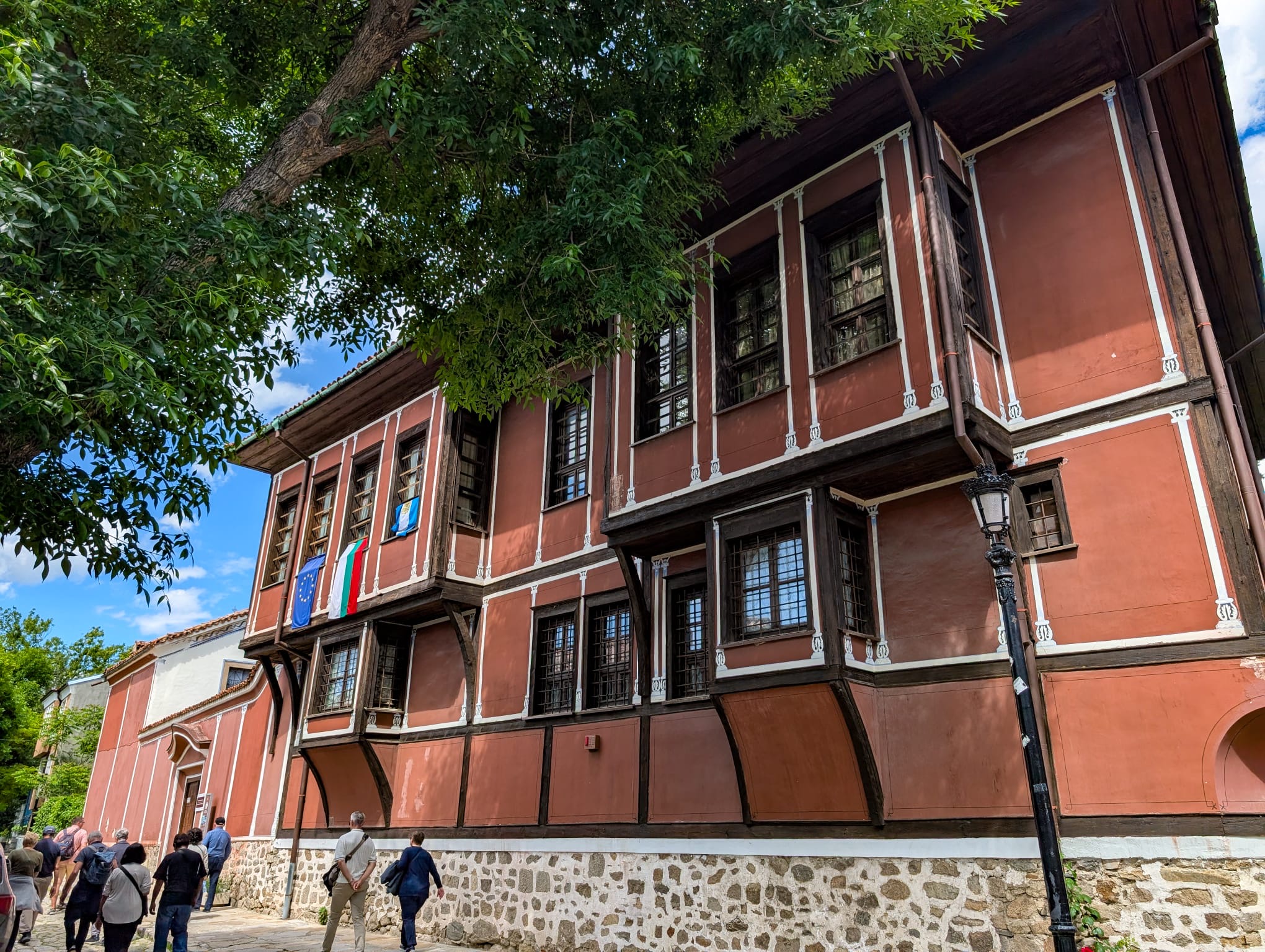 Day 12 – From Sofia to Plovdiv: Through History to the Edge of Europe
Day 12 – From Sofia to Plovdiv: Through History to the Edge of Europe
As our transcontinental journey neared its final chapter, we departed the city of Sofia mid-morning, once again by road for Plovdiv—Bulgaria’s second-largest city and a place of profound historical depth. The journey, which took just over two hours, carried us through verdant countryside and rolling hills, distant mountains, glimpses of rustic villages and wide-open plains, offering a peaceful prelude to the cultural riches ahead.
Upon arrival in Plovdiv, accompanied by our local guide and began exploring one of Europe’s oldest continuously inhabited cities. Like Rome, Plovdiv straddles seven hills, but its roots stretch even deeper into the past, with evidence of settlement dating back over 6,000 years.
We focused our visit on the city’s beautifully preserved Old Town, a charming district of cobblestone streets, where every corner seemed to whisper the tales of empires gone by. The area is renowned for its colourful National Revival–era mansions—elegant, creaky wooden homes now repurposed as intimate museums and galleries. One such home is the Hindliyan House, a significant historical landmark in Plovdiv’s Old Town. It was once the opulent home of Stepan Hindliyan, a wealthy Armenian merchant, and showcases the lavish lifestyle of the time through its exquisite period furnishings, painted ceilings, and unique architectural details. The house is a well-preserved example of Bulgarian National Revival architecture.
We admired ornate façades, bay windows, and shaded courtyards as we wandered past artisan shops and leafy squares. An interesting and surprising contrast in the centre of the city, is a street of inviting al fresco cafes and eateries, set next to a 14th century mosque which is well a look inside.
Another highlight was the Roman Theatre, remarkably intact and still used today for concerts and performances. Set against the backdrop of the Rhodope Mountains, its ancient stone seats seemed to echo with the applause of centuries.
As evening fell, we enjoyed a final meal together in one of the Old Town’s atmospheric restaurants, reflecting on the rich experiences of the past days—stretching from Budapest to the Balkans. Later, under a canopy of stars, we returned to the station to board the overnight sleeper train to Istanbul—our final destination. The rhythmic sway of the carriage and the soft hum of the tracks carried us toward the Bosphorus, as we drifted to sleep somewhere between continents.
